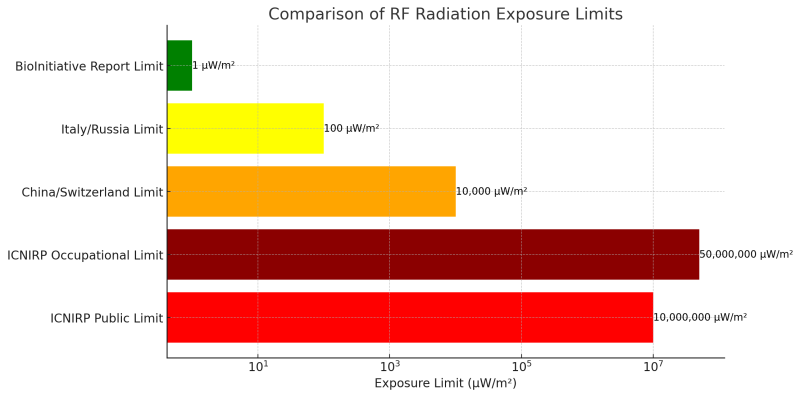The debate over radiofrequency (RF) radiation exposure limits is a conflict between two perspectives:
- The industry-backed, thermally focused ICNIRP/WHO guidelines
- The independent, biologically focused BioInitiative Report
Here’s why the BioInitiative Report holds more weight for those concerned about health risks:

The WHO and ICNIRP Follow an Outdated, Industry-Friendly Model
The ICNIRP and WHO guidelines are based on a thermal effects model, meaning they only consider RF radiation dangerous if it causes heating of human tissue. These guidelines were largely established in the 1990s, before modern research on non-thermal effects became widely available.
- ICNIRP’s Close Industry Ties: Many ICNIRP members have documented conflicts of interest, with connections to the telecommunications industry.
- WHO’s RF Working Group Controversy: Some of the scientists advising WHO on RF safety have also been linked to industry-funded studies, raising concerns about bias.
In contrast, the BioInitiative Report is entirely independent, compiled by 29 scientists, researchers, and public health experts from around the world, who receive no funding from telecom industries.
The BioInitiative Report Accounts for Non-Thermal Biological Effects
Unlike the WHO/ICNIRP, which ignores health impacts below tissue-heating levels, the BioInitiative Report reviews over 1,800 studies showing biological effects at levels thousands to millions of times below current safety limits.
- DNA Damage: Studies show RF exposure can induce DNA breaks, which could increase cancer risk. (REF: Lai & Singh, 1995)
- Oxidative Stress & Inflammation: Exposure to RF can cause an increase in reactive oxygen species (ROS), a key factor in neurodegenerative diseases. (REF: Yakymenko et al., 2015)
- Blood-Brain Barrier Disruption: RF exposure has been shown to make the brain more permeable to toxins. (REF: Salford et al., 2003)
- Fertility Damage: Studies indicate that RF exposure lowers sperm count, motility, and viability, potentially impacting reproduction. (REF: Agarwal et al., 2009)
The WHO and ICNIRP dismiss these effects simply because they do not cause immediate heating, even though scientific evidence has shown biological damage at levels far below their safety thresholds.
WHO/ICNIRP Guidelines Lag Behind Scientific Findings
Many countries have stricter RF limits than ICNIRP, based on newer research:
- Italy & Russia: Set limits at 100 μW/m²
- Switzerland & China: Set limits at 10,000 μW/m²
- ICNIRP/WHO Limit: 10,000,000 μW/m² (for public exposure)
The BioInitiative Report suggests an even lower precautionary level of 1 μW/m², aligning with studies that show health effects occurring at 0.1 μW/cm².
The fact that some governments have already rejected ICNIRP’s standards proves that even policymakers recognize they are not protective enough.
Historical Precedent: The WHO Has Downplayed Risks Before
This wouldn’t be the first time WHO delayed action on a public health crisis due to industry influence:
- Tobacco: WHO downplayed health risks in the 1950s-60s while independent researchers proved smoking caused lung cancer.
- Asbestos: Industry influence kept asbestos on the market long after it was proven deadly.
- Lead in Gasoline: WHO and regulators took decades to acknowledge the neurotoxic effects of lead exposure.
RF radiation may be following the same historical pattern—an emerging health crisis dismissed due to industry pressure, only to be fully acknowledged decades too late.
BioInitiative’s Findings Align with Court Rulings Against the FCC
In 2021, a U.S. federal court ruled against the FCC, stating that the agency failed to properly review evidence of non-thermal biological effects before reaffirming outdated RF exposure limits.
- The court cited scientific evidence ignored by the FCC—the same evidence emphasized in the BioInitiative Report.
- This ruling forced the FCC to reconsider its standards, further proving that regulatory agencies have not adequately addressed the risks.
Conclusion: BioInitiative Report is a Better Safety Standard
✅ Independent & Unbiased: No industry funding, unlike ICNIRP/WHO.
✅ Includes Latest Science: Covers 1,800+ studies on non-thermal effects.
✅ Supported by Court Rulings: The FCC lost a case for ignoring this evidence.
✅ Used by Cautious Governments: Some countries set stricter limits than ICNIRP.
Bottom Line
ICNIRP and WHO prioritize industry growth over public safety by failing to update their standards to reflect modern scientific findings. The BioInitiative Report, however, is compiled by independent scientists with no financial ties to telecom interests, making it a far more credible and trustworthy source for health-conscious individuals.